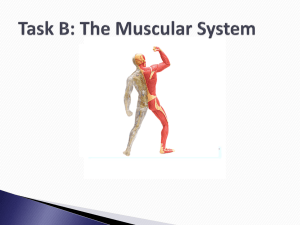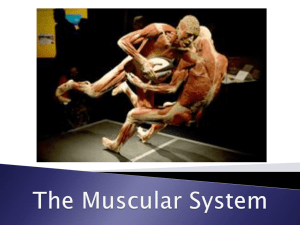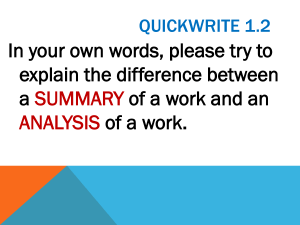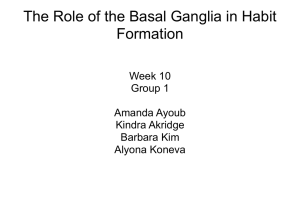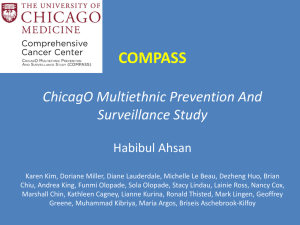Voice 7 Neurogenic Voice disorders 1
advertisement
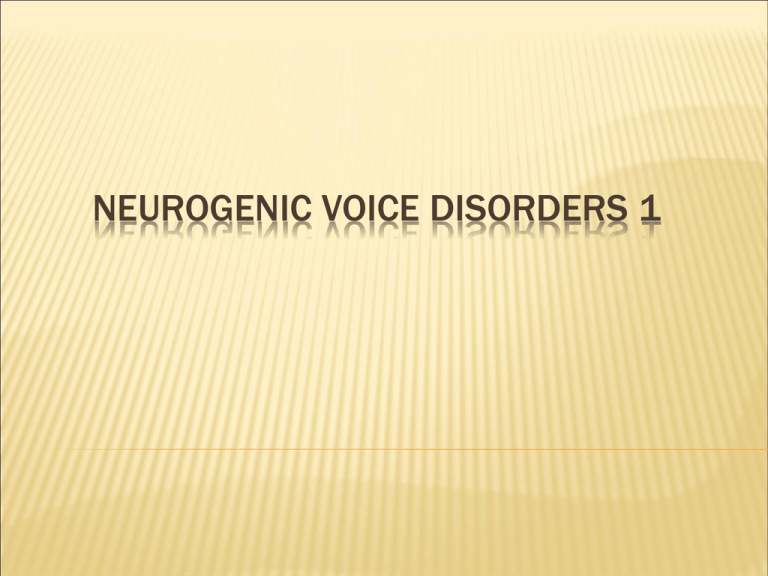
NEUROGENIC VOICE DISORDERS 1 TOPICS Anatomy and function of the Nervous System for Speech Common Types of neurogenic voice disorders ANATOMICAL DIVISION OF THE NERVOUS SYSTEM o Central Nervous System (within bone):中枢神经系统 * Cerebrum大脑 * Cerebellum小脑 * Brainstem脑干 * Spinal Cord脊髓 o Peripheral Nervous System 周围神经系统 (outside bone): * 12 pairs of Cranial Nerves12对脑神经 * 31 pairs of Spinal Nerves 31对脊神经 * Sensory Receptors 感受器 MOTOR SYSTEM运动系统 Efferent connections of cortex frontal lobe 大脑皮层传出结构 Basal ganglia 基底神经节 Cerebellum 小脑 额叶 MOTOR SYSTEM运动系统 Descending pathways to motor nuclei of cranial and spinal nerve 脑及脊神经运动核的下行通路 Efferent fibers within cranial and spinal nerves 脑及脊神经内的传出纤维 Striated muscle 横纹肌 SPEECH MOTOR SYSTEM Final common pathway 终端通路 Direct activation pathway 直接运动通路 Indirect activation pathway 间接运动通路 Control circuits 控制回路 FINAL COMMON PATHWAY AND SPEECH Paired cranial nerves supplying muscles involved in phonation, resonance, articulation and prosody. 12对脑神经控制发声、共鸣、构音和音律方面的肌肉 Paired spinal nerves involved in respiratory activities. 31对脊神经参与呼吸方面的运动 DIRECT ACTIVATION PATHWAY AND SPEECH Upper motor neuron system 上运动神经元系统 Corticobulbar tract: influence activities of cranial nerves 皮质延髓束:影响脑神经的活动 Corticospinal tract : influence activities of spinal nerves 皮层脊髓束:影响脊神经的活动 CORTICOSPINAL TRACT 皮层脊髓束 part of the Pyramidal Pathways goes from the cortex to the spinal cord provides innervation for skeletal muscles made up of over 1 million fibers which arise from the cerebral cortex and other motor areas of the brain CORTICOSPINAL TRACT CONTINUED also responsible for inhibition of reflexes Lesions on this tract would cause Muscle weakness Loss of voluntary use of muscles Loss of muscle tone Babinski Reflex Natural reflexes that we have as infants that go away with time CORTICOBULBAR TRACT皮质延髓束 is NOT a tract of the spinal cord very important for speech production arises from the premotor and somesthetic (body sense) regions of the parietal lobe of the cortex enters the brainstem provides innervation to many muscles of the face, neck, pharynx and larynx INDIRECT ACTIVATION PATHWAY AND SPEECH Reticular formation(网状结构): Vestibular nuclei(前庭神经核): Mediate consciousness, some portions excite extensor(伸肌) motoneurons and inhibit flexor(屈肌) motoneurons other portions inhibit extensor motoneurons and excite flexors. Corticoreticular tract modulate the activities of the eye and neck muscles. Vestibulospinal tract facilitate reflex activity and control muscle tone. Red nuclei(红核): Corticorubral tract and rubrospinal tract, influence flexor muscle groups on the limbs. INDIRECT ACTIVATION PATHWAY AND SPEECH Function: Effects of damage: regular reflexes and posture, tone, and associated activities that provide a framework on which the direct activation pathway can accomplish skills, discrete actions. Lesions above the midbrain and red nucleus produce increased extensor tone in the legs and increased flexor tone in the arms. lesions below red nucleus produce a generalized increase in extensor tone. Lesion below medulla produce generalized flaccidity in muscles. UMN lesions include direct and indirect activation pathway. CONTROL CIRCUITS Do not have direct contact with LMN. Basal ganglia control circuit Cerebellar Influence control circuit movement through cerebral cortex BASAL GANGLIA CONTROL CIRCUITS AND SPEECH Basal ganglia: caudate nucleus(尾状核), putamen(豆状核) and globus pallidus(苍白球) , also substantia nigra(黑质) and subthalamus nucleus(丘脑底核) . The balance between acetylcholine(乙酰胆碱) and dopamine(多 巴胺) is important in motor control. Inhibitory neurotransmitter in BG is GABA. Function: Regulate muscle tone, Regulate movements associated with goal-directed activities, Regulate automatic activities, Regulate postural adjustments during skilled movements, Regulate the relationship of required movement to the environment Regulate the learning of new movements. BASAL GANGLIA CONTROL CIRCUITS AND SPEECH Effects of damage: Disease of substantia nigra cause Hypokinesia Increased muscle tone Increased resistance to passive movements Reduced range of movement (rigidity) Affectively expressionless. Hyperkinesia result from excessive activity in dopaminergic nerve fibers cause involuntary movements. CEREBELLAR CONTROL CIRCUIT AND SPEECH Cerebellar hemispheres: control movement of ipsilateral side of body. Flocculonodular lobe(绒球小结叶): modulate equilibrium and orientation of head and eyes. Anterior lobe(小脑前叶): regulating posture, gait, and truncal tone. Posterior lobe(小脑后叶): coordinate skilled, voluntary muscle activity and muscle tone. CEREBELLAR CONTROL CIRCUIT AND SPEECH Reciprocal connections(交互连接) with cerebral cortex; Auditory feedback and proprioceptive(本体感受) input from speech muscles, tendons and joints; Reciprocal connections with brainstem components of the indirect activation pathways, and cooperative activity with the basal ganglia control circuit VAGUS NERVE迷走神经 Two important branches: Superior laryngeal nerve(SLN)喉上神经 internal and external laryngeal nerve Recurrent laryngeal nerve (RLN)喉返神经 Function: Innervation of striated muscles of the soft palate, pharynx, and larynx 支配软腭咽喉的横纹肌 Sensation from soft palate, pharynx and larynx 接受软腭、咽 腔和喉腔的感觉 VAGUS NERVE迷走神经 Unilateral LMN lesion单侧下运动神经元: affect phonation Bilateral LMN lesion双侧下运动神经元受损: affect resonance, phonation, prosody and clarity of articulation构音清晰度, and swallowing吞咽. Produce weakness of soft palate, pharynx, and larynx. CLASSIFICATION OF NEUROLOGICAL DISORDERS OF VOICE Hypoadduction Paralysis Hyperadduction Ataxic Disorders Mixed Disorders HYPOADDUCTION 关闭不严 Myasthenia Gravis重症肌无力 breathiness Parkinsonism 帕金森症 monopitch and reduced loudness Laryngeal paralysis 喉麻痹 breathiness PARALYSIS麻痹 – SUPERIOR LARYNGEAL NERVE喉上神经 Unilateral paralysis单侧声带麻痹 may see elevation of affected fold or shortening of VF 可看到受损声带位置抬高或声带变短 Bilateral paralysis 双侧声带麻痹 limp flaccid appearance bowed and short 麻痹部位松弛、弓形变短 PARALYSIS 麻痹– RECURRENT LARYNGEAL NERVE喉返神经 Unilateral or bilateral 单侧或双侧 VF/s appear flaccid and floppy声带变得无力、松软 Adduction position complete完全中位, paramedian旁中位, or bilateral外展位 Abduction position complete, paramedian, or bilateral HYPERADDUCTION关闭太紧 Spasmodic Dysphonia 痉挛性发音障碍 Essential tremor 特发性震颤 Huntington’s Chorea舞蹈症 SPASMODIC DYSPHONIC痉挛性发音障碍 laryngeal dystonia 喉肌张力障碍 Adductor (ADSD) 内收性 strained strangled quality 发音紧张 Spasms triggered by vowels 发元音易痉挛 Abductor (ABSD)外展性 Interspersed breathy spasms 全程气息音 Difficulty transitioning from voiced to voiceless 从浊音难过 渡到清音 ESSENTIAL TREMOR特发性震颤 Not considered a dystonia不认为是肌张力异常 Regular involuntary movement规律的不自主运动 ATAXIC DISORDERS Cerebellar ataxia小脑运动失调 MIXED DISORDERS Multiple sclerosis多发性硬化 Traumatic brain injury ITS ALL FOR TODAY!



